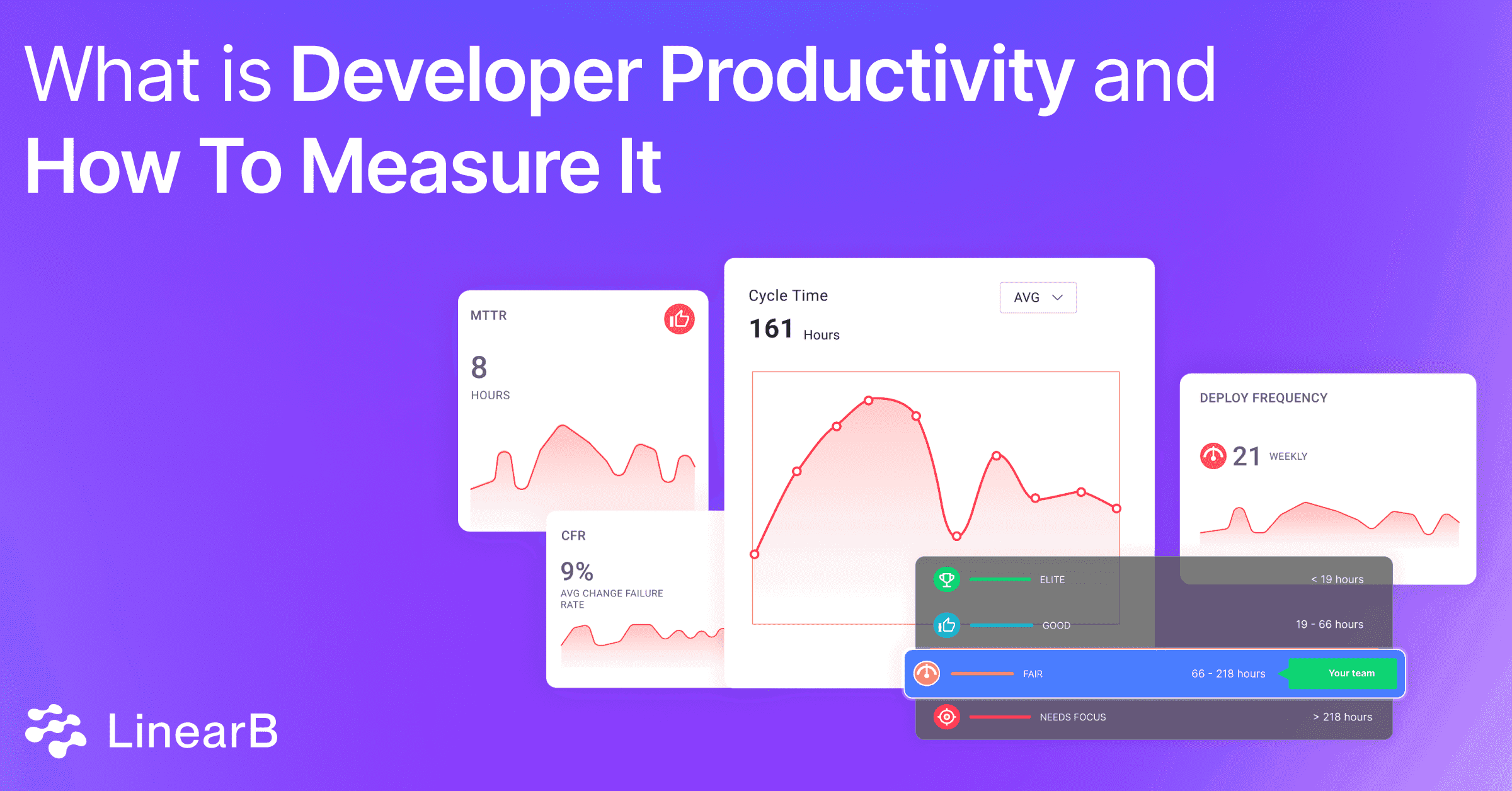As modern engineering organizations look for ways to improve efficiency, developer productivity initiatives are at the forefront. Developer productivity is not just about pushing out more code—it’s about how effectively developers can produce high-quality work that drives business outcomes. This blog offers a look at what developer productivity is, why it’s important, and how engineering leaders can take actionable steps to improve it.
What is Developer Productivity?
Developer Productivity refers to the effectiveness and efficiency with which software developers produce high-quality code and complete projects. It encompasses several factors, including:
- Code Quality: Writing clean, maintainable, and bug-free code.
- Speed: The pace at which developers complete tasks and deliver features
- Efficiency: How well developers use tools, resources, and time to achieve their goals
- Collaboration: How well developers work with others, including communication and teamwork
- Problem-Solving: The ability to effectively tackle and resolve technical challenges
- Adherence to Best Practices: Following industry standards and practices to ensure robust and scalable solutions.
Improving dev productivity often involves optimizing workflows, providing the right tools, reducing distractions, and fostering a supportive work environment. However, the notion of measuring–much less accelerating– developer productivity is often met with healthy skepticism, if not outright hostility.
Challenges and Benefits of Measuring Developer Productivity
Many engineering leaders face resistance when trying to measure productivity. There’s often apprehensions about whether measuring developer productivity can lead to unintended consequences or harm team culture. But all the resistance and objection in the world–however valid– doesn’t change the fact that organizational leaders are under increased pressure to improve efficiency and value creation.
Anything worth having doesn’t come easily–improvements to dev productivity are no exception. Whatever your engineering organization looks like, odds are you’re dealing with at least one, if not all, of the following hurdles.
Data and Insight
The desire for lots of data is a complex issue. Wanting more data is a solid and rational position, as within data lies the insights that when acted upon can help you:
- Make the best decisions possible in any given situation
- Dramatically increase developer productivity
For many engineering organizations, an overabundance of data exists—often in different formats from different sources and at different levels. Generating meaningful, actionable insight from this data can become a full-time job that takes too much time and resources.
When teams break down data silos and see project management, source code management, and engineering resourcing data in one place–improving dev productivity becomes a much easier task.
End-to-end visibility–from how work flows through the pipeline to how engineering investments and project resourcing impact overall spend and budgets–enables every part of your organization to make better decisions and optimize ways of working. Correlating these disparate data points in a single platform reveals a larger story and provides actionable insight.
Everyone from the team leads all the way up to the CTO will improve processes if they have unified visibility into what matters most to them. And it shouldn’t require 10 different dashboards in 10 different tools to get it.
Software Delivery Processes
Measuring developer productivity is challenging because development involves ideation, planning, and other intangibles that go beyond output metrics like lines of code or deployments. These metrics often miss important context, leading to incorrect evaluations. The lack of standardization across tools and practices further complicates productivity measurement. However, when metrics are applied properly and paired with meaningful conversations, they can drive efficiency, improve business outcomes, boost developer satisfaction, and promote continuous improvement.
Change Management
Engineering organizations constantly face change, whether from mergers, new tools, or policy shifts, some of which lead to productivity gains. The ability to adapt quickly, anticipate impacts on productivity, and maintain focus on delivering value is critical. Achieving this requires visibility into processes, team dynamics, project resources, and developer health.
With unified insights into these areas, you can assess how changes affect productivity, report to stakeholders, and develop strategies to mitigate risks or capitalize on gains. This helps forecast outcomes, maintain promises to the business, and master change management.
Additionally, a positive developer experience—supported by data-driven optimization—boosts satisfaction, engagement, and retention, which in turn enhances productivity and alignment with business goals.

Key Metrics to Measure Developer Productivity
To effectively measure productivity, it’s crucial to focus on the right metrics that provide insight into both the efficiency of the process and the quality of the output. Developer productivity is a multi-faceted concept that encompasses three key areas: efficiency, effectiveness, and experience. Here’s a breakdown of these areas and their related metrics:
Efficiency
Efficiency refers to how quickly and smoothly developers can complete tasks with minimal waste. Key metrics include:
- Cycle Time: Measures the time it takes to get a piece of code from pull request to production. This is one of the best indicators of development team efficiency, as it tracks the entire PR process—one of the most challenging parts of development.

- PR Maturity: Reduces back-and-forth in pull requests to ensure faster integration of code changes. A higher maturity level leads to quicker and more decisive reviews.
- PR Size: Smaller PRs mean faster pickup time, reviews, and cycles, leading to a shorter time to value.
- Code Churn and Rework: Reducing the need for frequent code changes by getting things right the first time.
- Stability (Change Failure Rate and Mean Time to Recovery): These metrics show how quickly teams can resolve issues. High operational efficiency tends to drive improved quality, which in turn boosts stability.
- Cognitive Load: Reducing multitasking, managing work-in-progress (WIP), and minimizing distractions to maintain focus.
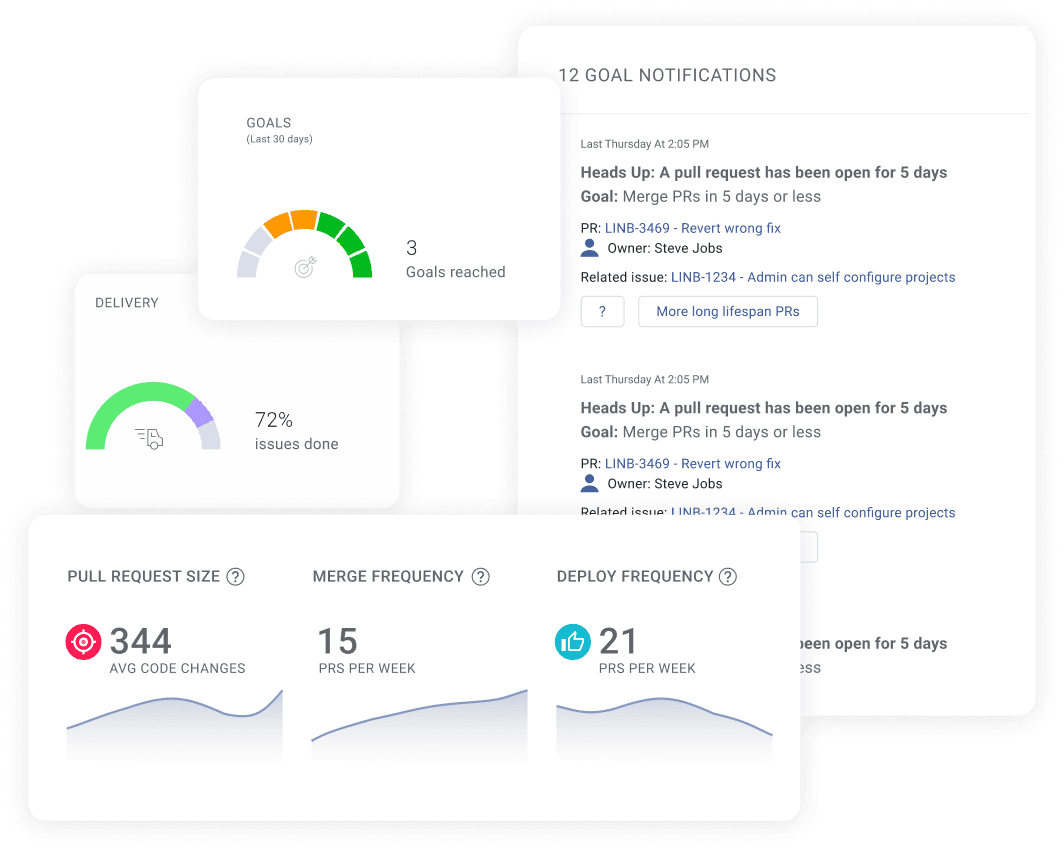
Effectiveness
Effectiveness focuses on doing the right tasks that align with business goals and contribute meaningfully to the team and organization. Key metrics include:
- Alignment with Business Goals: Ensuring that tasks and projects contribute directly to business objectives.
- Resource Allocation: Assigning the right people and the correct number of people to projects.
- Accuracy Scores: Focusing on scoped work (Planning Accuracy) while maintaining operation flexibility to adapt to the regular ebb and flow of engineering organizations (Capacity Accuracy).
- Consistency: While predictability and keeping promises to the business is important, so is operational consistency. Teams should strive for consistent and steadily improving accuracy scores as well as cycle time to ensure accurate timeline forecasts and kept promises.
- Balancing New Value and Maintenance: Striking a balance between creating new features and maintaining existing systems (keeping the lights on).
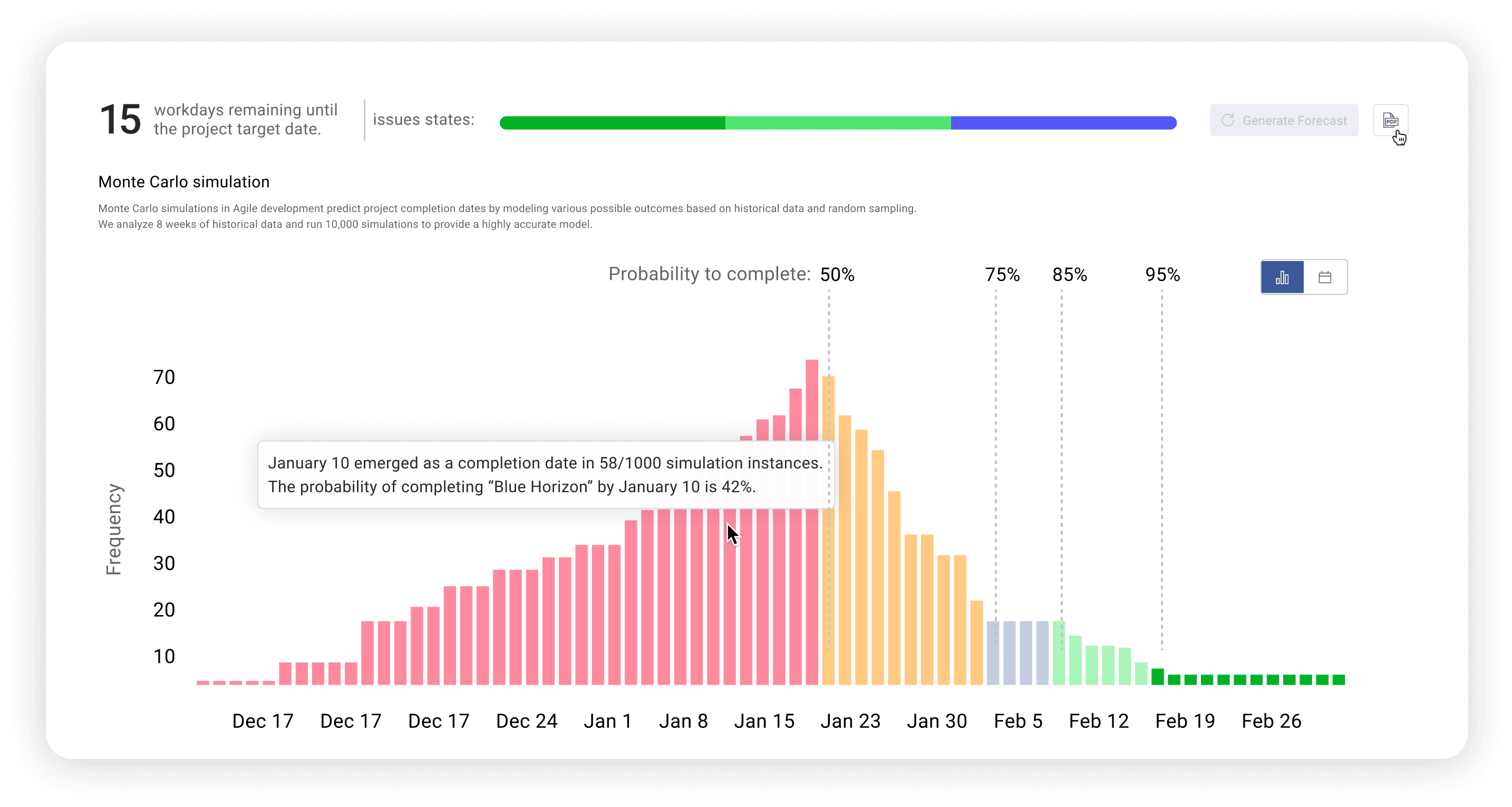
Experience
Developer experience (DevEx) refers to the morale and engagement of developers, which directly impacts their productivity and job satisfaction. Key metrics include:
- Idle or Wait Time: This shows the time between the various phases of the pull request process. Reducing idle time helps keep developers focused and engaged.
- Task Balance: Ensuring a healthy mix of tasks to keep developers motivated, balancing new challenges with routine work.
- Skill and Knowledge Expansion: Encouraging developers to expand their skill sets and continuously improve their understanding of the codebase.
- WIP: Managing work-in-progress (WIP) to avoid overloading developers, helping them maintain focus and avoid burnout.
- Coding vs. Code Review: Balancing time spent on writing code with reviewing and providing meaningful feedback on others’ code to maintain high code quality standards
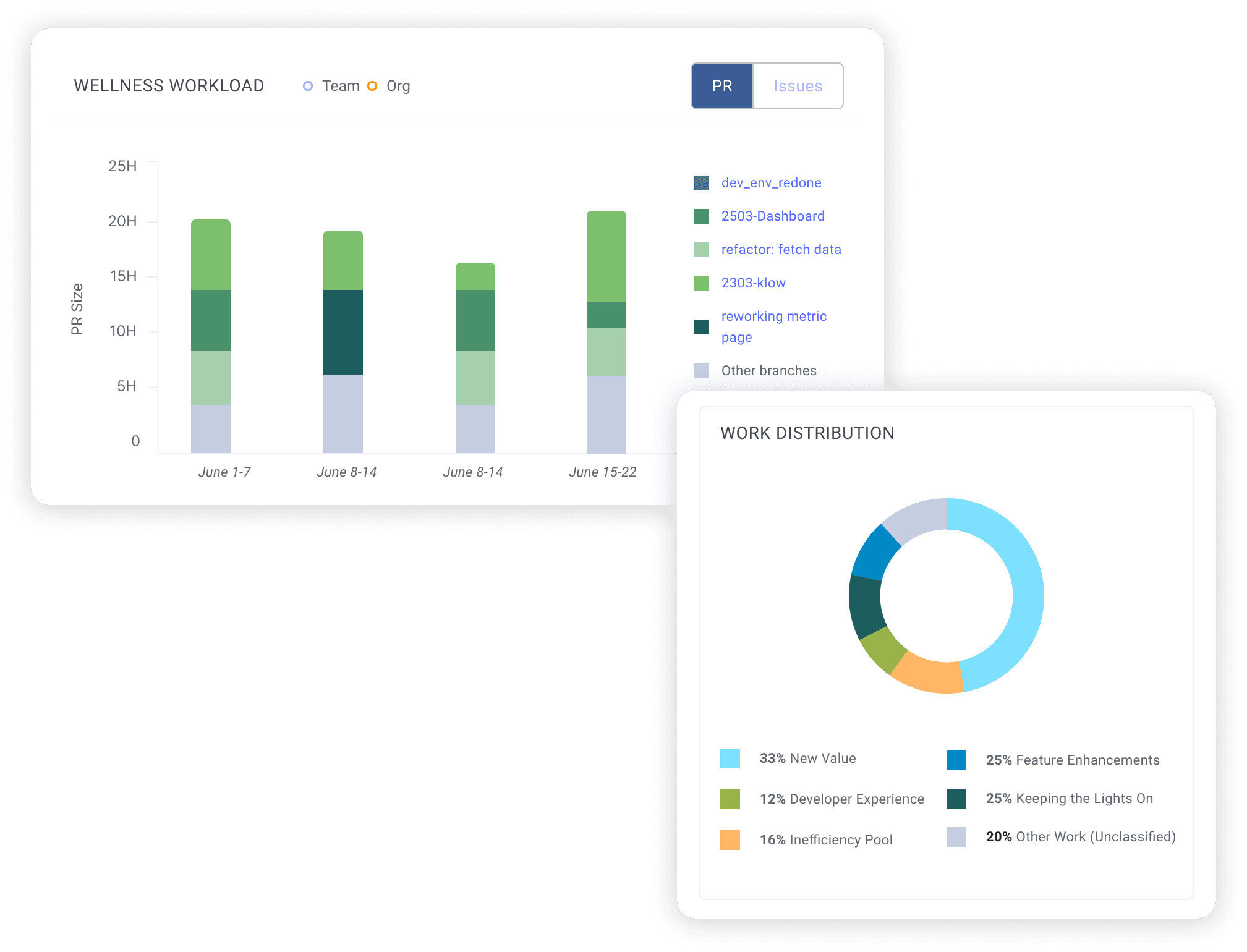
By understanding and optimizing these aspects, engineering leaders can significantly improve both individual and team productivity, driving better outcomes for both the developers and the business.
How DORA and Space Metrics Impact Developer Productivity
You’ve likely heard of DORA and SPACE. Both methodologies are valuable and offer key insight into overall productivity.
With DORA, productivity is boiled down to four key metrics that reveal a team’s overall operating efficiency and output stability. These quantitative metrics are revealed through source code management (SCM) tools and issue trackers. SPACE offers both qualitative and quantitative metrics by capturing developer sentiment, collaboration, and communication, as well as more “conventional” KPIs–e.g. DORA metrics.
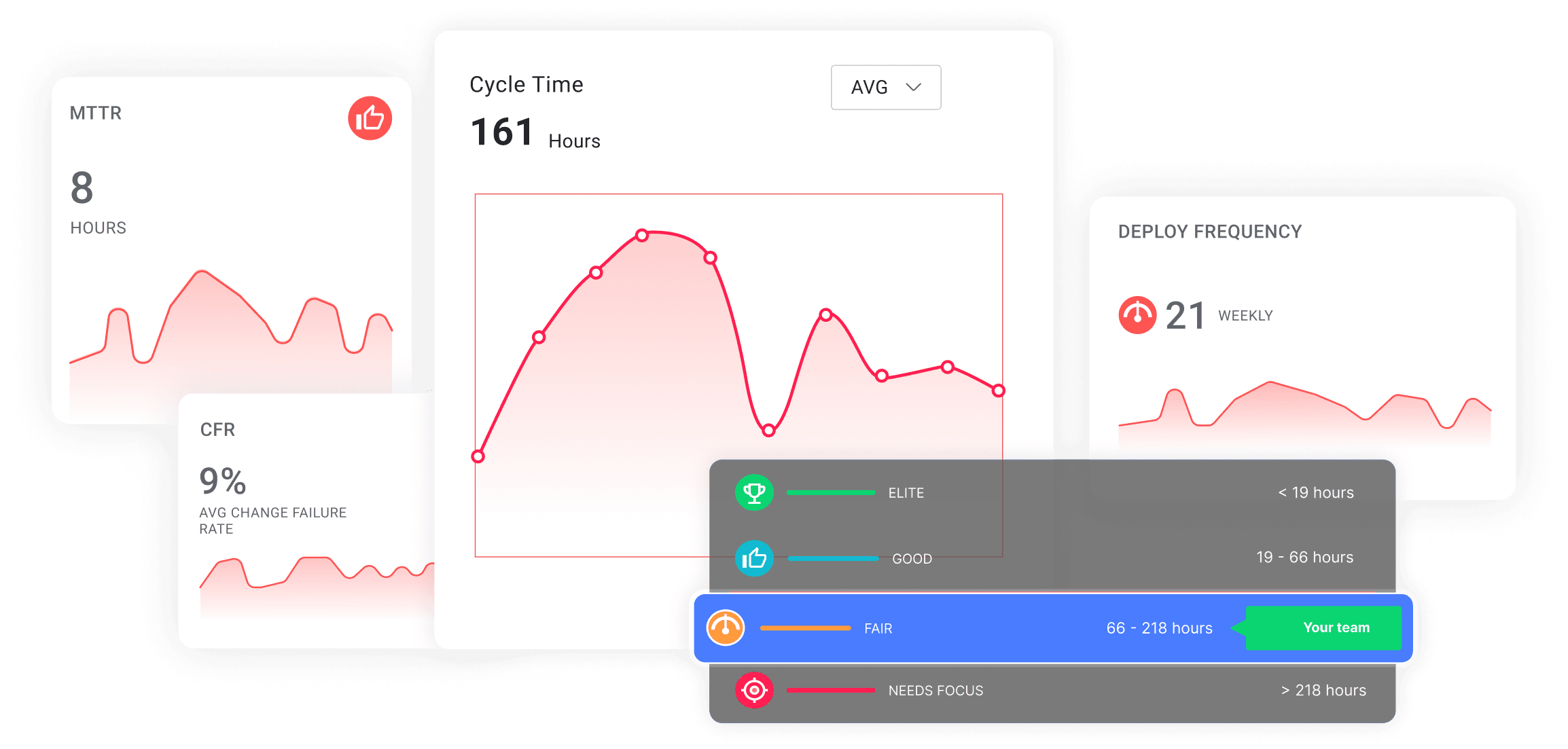
While both frameworks offer something, they have one key flaw: they only include lagging indicators, i.e., the metrics are calculated and presented after the code makes it into production. Teams need to focus on both leading and lagging indicators to improve productivity. Take deployment frequency, for example. This lagging indicator DORA metric offers some insight into a team's overall efficiency and, indeed, developer productivity. But short of telling your team to “deploy more frequently,” how do you improve this metric and overall efficiency and productivity?
Tools for Enhancing Developer Productivity
With the right tools, engineering leaders can significantly enhance developer productivity. Software Engineering Intelligence (SEI) platforms and automation play a critical role in reducing manual overhead and keeping developers focused on high-value work. SEI platforms make it easier to streamline code reviews, assign tasks, and monitor key metrics.
Automating the code review process can reduce idle time and eliminate bottlenecks. Features like pull request orchestration ensure that the right reviewer is assigned to the right task and small, low-risk changes are approved automatically. This helps developers focus on solving complex problems rather than getting bogged down in repetitive tasks.

You can also leverage SEI platforms to gain insights into the overall health of the development process. This helps leaders spot bottlenecks early and adjust strategies in real-time, enabling teams to optimize their workflow and drive continuous improvement.
Impact of Developer Experience on Developer Productivity
Developer experience and developer productivity go hand in hand. When inefficiencies cause teams to experience high cognitive load, frequent context switching, and unclear priorities, people tend to burn out and can’t deliver their best work. In contrast, teams with efficient processes facilitated by the right tooling and positive culture are generally more engaged and productive.
A great developer experience means providing a supportive environment where engineers can thrive. Automating toil, ensuring clear communication, and giving developers opportunities to learn are just some ways to improve DevEx. Ultimately, a team that feels supported and empowered will deliver better results.
Best Practices for Improving Developer Productivity
Enhancing developer productivity is crucial for a business to maintain a competitive advantage. To achieve this, a structured approach is essential. This section provides step-by-step instructions on accelerating developer productivity by focusing on three key areas:
- Goal setting using quantifiable engineering metrics
- Automating productivity improvement and toil reduction
- Using data to inform decisions, conversations, recurring syncs, and developer ceremonies.
By optimizing for each of these, organizations can create an environment where developers thrive and produce their best work.
Setting Data-Backed Team Goals
Effective goal setting is foundational for improving engineering execution and aligning R&D with business priorities–both essential components of overall developer productivity. Goals should be anchored around industry-standard measures of engineering performance, such as:
- DORA metrics (Deployment Frequency, Lead Time for Changes, Change Failure Rate, and Time to Restore Service) and leading indicators
- Business alignment KPIs (Resource Allocation and Investment Strategy
- Project planning, execution, and delivery metrics (like Accuracy Scores and Unplanned/Added Work)
- Engineering benchmarks
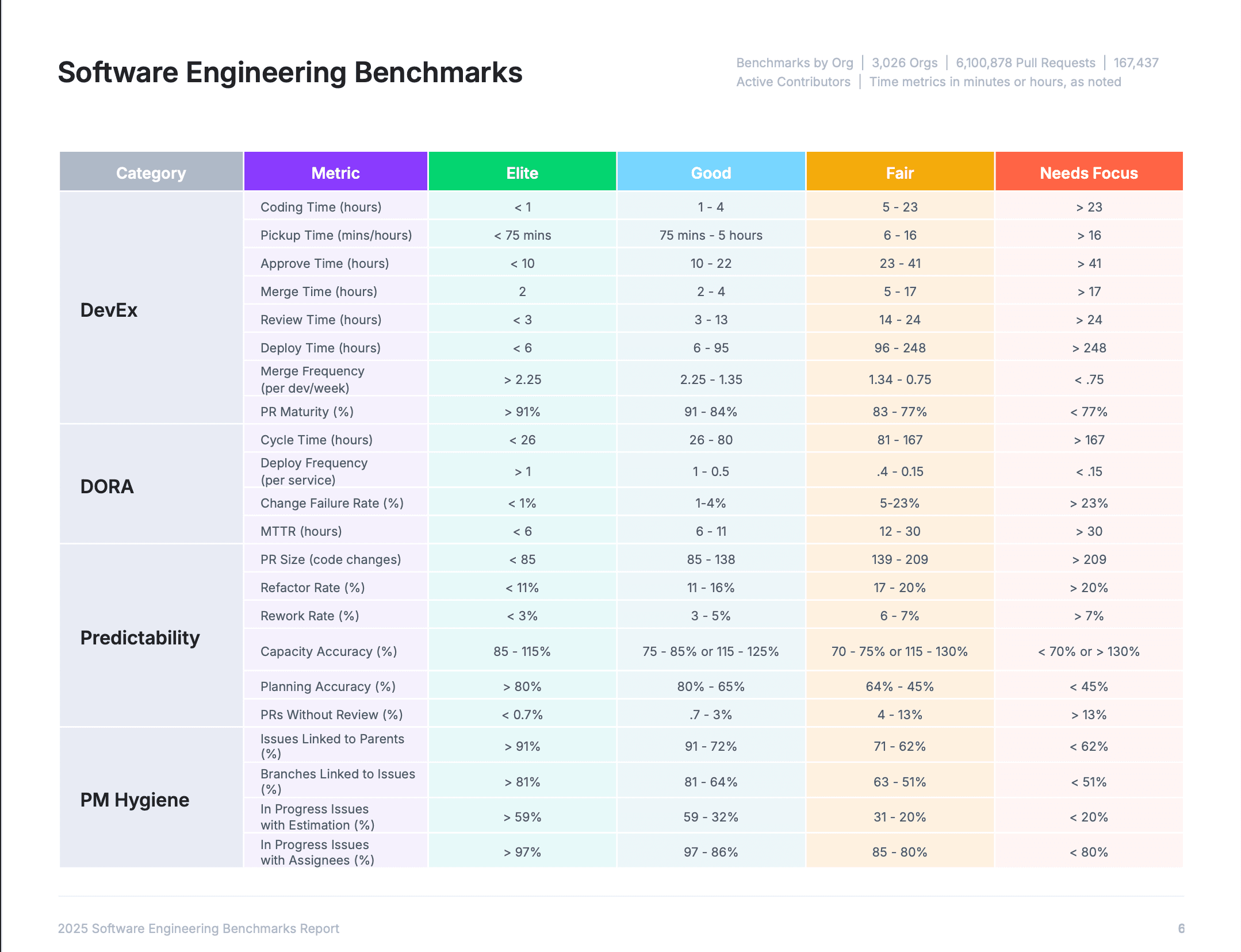
To ensure that engineering efforts contribute directly to the overall business success, it's crucial to align operational goals with business-level Objectives and Key Results (OKRs). Start by identifying the core business objectives, such as improving customer satisfaction, increasing revenue, or reducing operational costs. Then, translate these objectives into specific engineering goals that support these outcomes.
If a business objective is to improve customer satisfaction, an operational goal might be to reduce the number of customer-reported bugs by 30%. By doing so, each engineering effort is directly tied to a broader business goal, ensuring that the team's work is relevant and impactful.
Automate Developer Productivity Improvement and Toil Reduction
Automation plays a crucial role in increasing developer productivity by minimizing repetitive, manual tasks. For example, automating code reviews can reduce idle time and ensure that the right reviewer is assigned to each pull request based on expertise. Workflow automation tools allow teams to programmatically streamline processes, reducing toil and allowing developers to focus on high-value work. Automating tasks like PR classification, CI pipeline triggers, and code reviews can significantly improve the flow of work across your organization.
Use Developer Productivity Data to Improve Decision-Making Conversations and Developer Ceremonies
Data-driven decision-making is critical for fostering a culture of continuous improvement, providing the team with a better developer experience, and aligning your operational cadences with business goals.
By leveraging data, KPIs, and metrics, managers can establish better habits with their team that lead to more informed conversations, more effective performance reviews, and more productive recurring syncs and developer ceremonies.
For example, prior to reviews, whether quarterly or annually, use the Developer Coaching Dashboard to get data on developers' experience, well-being, and performance.
Informing Conversations and Enhancing Recurring Syncs and Ceremonies
Managers can use dev productivity data and metrics for more meaningful and actionable team conversations and getting more out of recurring syncs–like daily stand-ups, weekly check-ins, and sprint retrospectives. Here’s how:
- Setting Context: Use metrics to provide context during one-on-one meetings with developers. Discuss specific KPIs such as PR review time or PR size to highlight areas of strength and opportunities for improvement.
- Identifying Bottlenecks: Leverage data to identify and address bottlenecks in the development process. If review times are consistently high, discuss strategies to streamline the code review process with automation. If cycle time is increasing or the project seems to be going off the rails, discuss potential causes, examine risk indicators, and collaboratively develop solutions.
- Goal Alignment: Ensure individual goals are aligned with team and organizational objectives. Use data to show how individual contributions impact broader goals, fostering a sense of ownership and accountability.
- Celebrating Success: Use data to recognize and celebrate team achievements. Highlight metrics that show improvement and acknowledge contributions that led to success.
Conducting Performance Reviews
Performance reviews should be based on objective data to ensure fairness and transparency however, they should also incorporate context and sentiment. Here’s how to integrate metrics into performance reviews:
- Objective Metrics: To assess performance, use quantifiable metrics such as deployment frequency, code quality (e.g., change failure rate, rework), and contribution to team goals.
- Balanced Evaluation: To provide a balanced evaluation of performance, consider a mix of efficiency and quality metrics and remember to account for seniority as well as the different roles a developer plays on a given day (author vs. reviewer). If you’re having a conversation with a more senior developer, make sure to bring data on review time and reviews conducted, as well as what areas of the code base they’ve touched, workload data, and more. You’ll then have a more complete picture of the overall productivity of that developer.
- Continuous Feedback: Provide ongoing metrics-based feedback, not just during the formal review. This helps developers continuously improve and align their efforts with expectations.
Enhancing Regular Conversations and Check-Ins with Data
While data and metrics provide valuable insights, they should enhance regular conversations and check-ins with developers, not replace them. Here’s how to integrate data into these interactions effectively:
- Complement, Don’t Replace: Use metrics to augment the qualitative aspects of your conversations. Metrics provide a factual basis for discussion, but personal interactions give context and understanding that data alone cannot provide.
- Foster Open Communication: Encourage open dialogue where developers can share their perspectives on the data. This can lead to a better understanding of the underlying causes of certain metrics and foster collaborative problem-solving.
- Provide Personalized Feedback: Use data to provide specific and actionable personalized feedback. Discuss individual contributions and areas for improvement in the context of the team’s overall performance.
- Emphasize Support and Development: Use metrics to identify areas where developers might need additional support or training. This can help in tailoring development plans and providing resources that align with their growth needs. It is also a sure fire way to improve the developer experience.
- Build Trust: Be transparent about how data is used. Ensure developers understand that metrics are tools for improvement and not for monitoring individual performance. This builds trust and encourages a more positive attitude towards data-driven practices.
This approach not only enhances developer productivity and improves DevEx, but also ensures that teams are focused on delivering high-quality software that drives business success.
Moving the Needle on Developer Productivity
Measuring and improving developer productivity is how organizations can remain competitive and deliver high-quality software. By focusing on the right metrics, leveraging automation tools, and creating a positive developer experience, engineering leaders can boost both efficiency and team satisfaction.
Want to learn more about how you can measure and improve developer productivity? Download our Engineering Leader’s Guide to Accelerating Developer Productivity.

